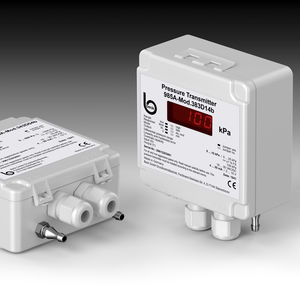
- Company
- Products
- Catalogs
- News & Trends
- Exhibitions
Differential pressure transmitter 988ceramic4-20 mA2-wire






Add to favorites
Compare this product
Characteristics
- Pressure type
- differential
- Technology
- ceramic
- Output
- 4-20 mA, 2-wire
- Electrical connection
- M12 connector
- Supply voltage
- 24 Vdc, 24VAC
- Fluid
- for air, for non-aggressive gases, for liquids
- Protection level
- IP65
- Applications
- for building automation, for compressors
- Other characteristics
- temperature-compensated, OEM, sanitary, high-overpressure
- Pressure range
Min.: 0 bar
(0 psi)Max.: 10 bar
(145.04 psi)- Process temperature
Min.: -25 °C
(-13 °F)Max.: 85 °C
(185 °F)
Description
The differential pressure transmitters of the 988 series are used to measure differential pressure and overpressure.
Monitoring of liquid and gaseous, non-flammable and non-aggressive media.
APPLICATIONS
Building automation
Measurement technology in the sanitary and industrial sector
Differential pressure measurement between supply and return in heating systems
Monitoring of filters, fans and compressors
Cooling systems for heating / air conditioning
Pressure range
For an optimal adaptation to the application, different pressure ranges are available. The measurement is carried out by a ceramic pressure measuring cell, temperature-compensated via internal PTC.
Electrical connection
The electrical connection of the transmitter is optionally available with a 4-pin standardized device plug according to DIN EN 175301 Form A, or with a 4-pin M12 flange plug, A-coded, according to DIN EN 61079.
OEM versions, assembled versions and different connection threads, as well as other measuring ranges are available on request.
Catalogs
Related Searches
- BECK pressure transmitter
- Pressure gauge
- BECK analog pressure transmitter
- BECK pressure switch
- Pressure probe
- Membrane pressure transmitter
- Stainless steel pressure transmitter
- Relative pressure transmitter
- BECK waterproof pressure transmitter
- BECK mechanical pressure switch
- BECK waterproof pressure switch
- Gas pressure transmitter
- Process pressure indicator
- Liquid pressure transmitter
- Threaded pressure transmitter
- Gas pressure indicator
- Analog pressure probe
- Waterproof pressure gauge
- BECK diaphragm pressure switch
- Process pressure transmitter
*Prices are pre-tax. They exclude delivery charges and customs duties and do not include additional charges for installation or activation options. Prices are indicative only and may vary by country, with changes to the cost of raw materials and exchange rates.









